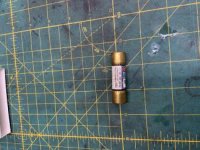ChipChaff
Cast Iron
- Joined
- Dec 15, 2007
- Location
- Mid-Wisconsin
Hi all:
Yes, I am embarrassed. Mice have nested in the electrical box of my DV-59 and I'm cleaning up and need to replace at least one fuse - which lost its label. The fuse is located 5 1/2 inches from the bottom of the box and 7 inches from the right side. The fuse is vertically oriented in its holder and is 2 inches long and 1/2 inch wide. If anyone can give me the values of the fuse, I'd appreciate it. I think it's 1.5v but not sure enough to want to go with that. The mice pretty much rendered the schematic unreadable. I hate those meeces to pieces! Never would have thought the little bastardos could get into the electrical box - went to start it up after months of idleness and got an ugly hummmmmmmmm.
Thinking ahead, which is rare for me, a source for Hardinge electrical components would probably be a great help as well - no telling what's corroded beyond cleaning.
Yes, I am embarrassed. Mice have nested in the electrical box of my DV-59 and I'm cleaning up and need to replace at least one fuse - which lost its label. The fuse is located 5 1/2 inches from the bottom of the box and 7 inches from the right side. The fuse is vertically oriented in its holder and is 2 inches long and 1/2 inch wide. If anyone can give me the values of the fuse, I'd appreciate it. I think it's 1.5v but not sure enough to want to go with that. The mice pretty much rendered the schematic unreadable. I hate those meeces to pieces! Never would have thought the little bastardos could get into the electrical box - went to start it up after months of idleness and got an ugly hummmmmmmmm.
Thinking ahead, which is rare for me, a source for Hardinge electrical components would probably be a great help as well - no telling what's corroded beyond cleaning.






